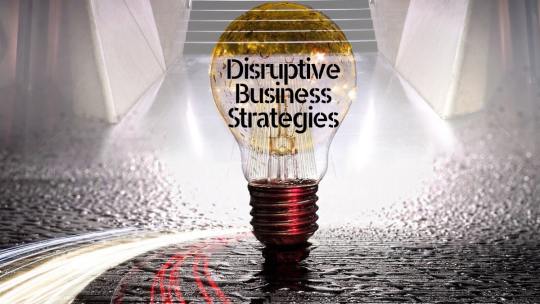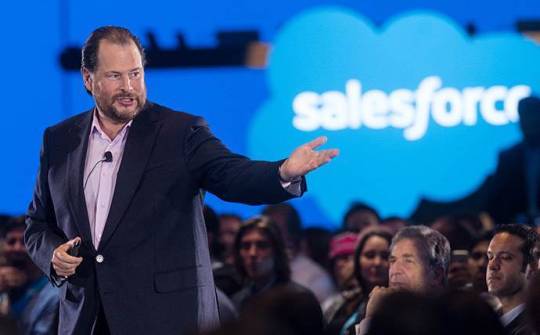#Business leadership
Text
BBA is a versatile undergraduate program designed to provide students with a solid foundation in business principles and practices. This degree aims to equip students with the skills and knowledge necessary for a successful career in various business fields. Lloyd Institute offers a comprehensive BBA program with specializations in General Management and Data Analytics.
#Business Administration#BBA Program#Management Education#Undergraduate Business Degree#Career in Business#Business Leadership
2 notes
·
View notes
Text
Disruptive Business Strategies: Innovate, Compete, and Succeed
Disruptive business strategies are innovative approaches that challenge the status quo of the industry and introduce new products, services, or business models that change the way things are done. Here are a few examples of disruptive business strategies that have expanded businesses worldwide:
Uber: Uber is a ride-sharing service that disrupted the traditional taxi industry. Instead of owning a…

View On WordPress
#agile development#business competition#business leadership#business strategy#business success#business tips#competitive advantage#competitive edge#creative culture#emerging trends#grow business#industry norms#innovation#market disruption#market opportunity#marketing#technology#user experience
2 notes
·
View notes
Text
Empower Your Leadership: One-on-One Coaching for Middle and Senior Managers

Our Leadership coaching and development one on one sessions are recommended for Senior management executives willing to take the organisation to the next level. Typically we would recommend these meetings before the strategy kickoff sessions. This can help in organisational renewal. An inspiration to create and implement the next version of the organisation. Develop insights to enable “Change” and embrace meaningful “Challenge”. We expect more inspired and determined leadership to bring about better organisational changes. For more information visit our website and contact on given number- https://kabirlearning.in/leadership-coaching/
2 notes
·
View notes
Text
Entrepreneurial Leadership: What are the Advantages and Disadvantages?
🚀 Dive into the world of Entrepreneurial Leadership with our latest blog post! 💼
#leadership #entreprenuer #business #leaders
In the dynamic environment of the business world, entrepreneurial leadership has emerged as a potent force. The fusion of entrepreneurial zeal and leadership acumen characterize this leadership style. Entrepreneurial leadership is gaining popularity for its potential to drive business growth and innovation. This innovation is particularly important now during this time of tech advances in AI. As…

View On WordPress
#business#business leadership#entrepreneur#entrepreneurial leadership#leader#Leadership#Mindful Leadership#Mindfulness
2 notes
·
View notes
Text
Learn valuable insights on achieving success in business from top CEOs.
2 notes
·
View notes
Text
Salesforce CEO Marc Benioff Proclaims: 'The World is Shifting Towards the Indian Era'

At the annual Dreamforce event in San Francisco, Salesforce CEO Marc Benioff declared that the world is entering an “Indian era,” highlighting India's growing global significance. He noted, “There is no denying that India is about to enter a truly remarkable period. It’s a really exciting opportunity, as you can see.”
Benioff expressed strong confidence in Salesforce's expansion in India, where the company has over 11,000 employees. He emphasized the critical role of Indian operations in engineering and market engagement, pointing to major clients like the Bajaj Group. He praised Arundhati Bhattacharya, former SBI Chairperson and now head of Salesforce India, for her leadership in driving this growth. While Benioff did not disclose specific workforce expansion plans, he underscored India’s vital importance in Salesforce’s future strategy.
Additionally, Salesforce introduced its partner network, which includes industry giants like AWS, Google, IBM, and Workday, as well as "Agentforce," an autonomous AI tool aimed at optimizing business processes. He highlighted a collaboration with NVIDIA to provide advanced autonomous AI agents for enterprise applications.
Benioff predicted that these innovations would transform sales, marketing, and commerce, describing them as a significant leap beyond traditional chatbots. Addressing concerns about potential job losses due to AI, he reassured that there are pathways for workforce transition, noting that some companies have already successfully navigated this change.
To further strengthen its presence in India, Salesforce announced the appointment of Rahul Dravid, the celebrated Indian cricket star, as its first brand ambassador. Dravid will help Indian businesses leverage the Salesforce CRM platform to foster growth, aligning with the “Growing With India” campaign that promotes Salesforce’s comprehensive, user-friendly CRM solutions designed to elevate Indian enterprises.
READ MORE
#Salesforce CEO#Marc Benioff#Indian Era#Global Transition#Business Leadership#Economic Shift#India’s Influence#Tech Industry Trends#Future of Business#Innovation in India#news#business#success
0 notes
Text
Work Experience Letter Requirement for MBA vs. MS: Key Differences Explained
Are you wondering about the difference in work experience letter requirements for MBA vs. MS programs? Our latest post explores how these requirements vary in terms of the duration, nature of experience, and sources of recommendation letters. While MBA programs focus on leadership and business impact, MS programs prioritize technical skills and academic achievements.
For more insights on how to tailor your work experience letter for your desired program, visit our detailed guide on work experience letter requirements for MBA vs. MS.
#MBA#MS#work experience#recommendation letters#graduate programs#business leadership#technical skills#MBA vs MS#education abroad#application tips#professional background#academic achievements
0 notes
Text
Ever wonder what it's like to be a female co-founder? Here's a little taste!
0 notes
Text
0 notes
Text
Executive Presentation Skills: Strategies to Impress and Influence

In the realm of business leadership, Presentation Skills Training is crucial, especially for executives aiming to influence and impress their audience. Whether you're addressing a boardroom, potential investors, or your team, honing your presentation skills can significantly impact your professional success. Here are essential strategies to elevate your executive presentations.
1. Know Your Audience
Understanding your audience is fundamental. Tailor your message to their interests, knowledge level, and expectations. This ensures your content is relevant and engaging, fostering a deeper connection with your listeners.
2. Structure Your Presentation
A well-structured presentation keeps your audience engaged and your message clear. Start with a compelling introduction, followed by key points supported by data or anecdotes, and conclude with a strong closing statement that reinforces your main message.
3. Master the Art of Storytelling
Storytelling is a powerful tool in executive presentations. Craft a narrative that resonates with your audience, making complex information more relatable and memorable. Use real-life examples to illustrate your points and keep the audience invested.
4. Utilize Visual Aids Effectively
Visual aids can enhance your presentation by making information easier to understand. Use slides, charts, and videos to complement your speech, but avoid overcrowding them with text. Keep visuals clean, professional, and to the point.
5. Practice and Refine Your Delivery
Rehearse your presentation multiple times to refine your delivery. Pay attention to your tone, pace, and body language. Confidence and clarity in your speech can significantly influence your audience's perception of your message.
Conclusion
By implementing these strategies, executives can significantly enhance their presentation skills, leaving a lasting impression on their audience. Effective Presentation Skills Training is not just about delivering information, but about connecting, engaging, and influencing.
#executive presentation skills#presentation skills training#business leadership#storytelling in presentations#effective presentations#visual aids#public speaking for executives#presentation techniques#executive communication#professional presentations
0 notes
Text

Our Leadership coaching, Manager’s Training and development sessions are recommended for senior and mid level managers with high potential and deep interests to develop themselves.
#leadeship coaching bangalore#leadership coaching#leadership coaching companies in bangalore#leadership development#leadership coaching program#leadership#business leadership
0 notes
Text
Reasons to Attend Global Leadership Summit (GLS) 2024: A recap of GLS 2023 Special and What to Expect This Year
Global Leadership Network: Growing Leaders and Providing Leadership Growth for a Higher Purpose
Since 1992, the Global Leadership Network has inspired, challenged, and equipped leaders to become the sort of individuals who will positively impact their respective organizations, communities, and countries. Today, the Global Leadership Network continues to be a readily available resource providing…

View On WordPress
#Amy C. Edmondson#Arthur C Brooks#Business Leadership#Carey Lohrenz#Craig Groeschel#Dan Owolabi#Erwin Raphael McManus#Global Leadership Network#Global Leadership Summit 2024#Jo Saxton#Joni Eareckson Tada#Kindra Hall#Leadership#Leadership Books#Marcus Buckingham#Michael Jr.#Mike Krzyzewski#Molly Fletcher#Will Guidara
1 note
·
View note
Text
youtube
#entrepreneur#success story#billionaire#business leadership#inspiration#businessgrowth#role model#achievements#education#motivation#Youtube
1 note
·
View note
Text
#Salesforce CEO#Marc Benioff#Indian Era#Global Transition#Business Leadership#Economic Shift#India’s Influence#news#business#success#marketing#ceo#entrepreneur#successful
0 notes
Text
Achieving Diversity in Technical Roles Through Equitable Interviews - Technology Org
New Post has been published on https://thedigitalinsider.com/achieving-diversity-in-technical-roles-through-equitable-interviews-technology-org/
Achieving Diversity in Technical Roles Through Equitable Interviews - Technology Org
In the technology industry, there is an increasing focus on improving diversity and inclusion. However, interview practices often unintentionally disadvantage underrepresented groups. Studies show women, people of color, older candidates, and others face implicit bias during the interview process.
“We believe that interviews should never be a barrier to recognizing talent, skill, and ability in candidates regardless of their background,” says Dr. D Sangeeta, CEO of Gotara, an online business leadership acceleration platform used by over 30,000 women across 176 countries. “Our platform is built on empowering women across a multitude of industries to advance, and equitable interview practices are a necessity to make that possible.”
By taking proactive steps to remove bias from interviews, companies can work towards building more diverse, creative, and innovative teams. This article provides practical tips and guidelines for making interviews as fair and gender-neutral as possible.
Use Structured Interview Techniques
Unstructured interviews that rely on the “gut feeling” of the interviewer often introduce unconscious bias. Structured techniques that assess all candidates on the same predefined criteria can help reduce this. Some examples include:
Ask the same core technical questions of all candidates for a given role. Avoid asking different questions based on irrelevant factors like educational background.
Use standardized rating scales when evaluating responses instead of general impressions. Train interviewers on how to apply the scales.
Limit discussions around previous experience to focus on concrete skills a candidate possesses rather than perceived pedigree of past companies.
Prioritize Skills Over Cultural Fit
Seeking candidates that “fit” with company culture can reinforce homogeneity if not approached carefully. Technical skills should be the priority evaluation criteria. Only assess cultural alignment based on how a candidate demonstrates inclusiveness, cooperation and values that align with diversity goals.
“Seeking candidates that “fit” with company culture can reinforce homogeneity if not approached carefully,” explains Dr. D. Sangeeta, CEO of Gotara. “Technical skills should be the priority evaluation criteria. One always benefits from having complementary skills rather than a clone of themselves. When interviews are structured around skills rather than subjective impressions of candidates, it opens doors for those facing systemic biases and works towards undoing historical barriers many have faced.”
Train a Diverse Panel of Interviewers
Ensure women, people of color and other underrepresented groups are well-represented among the panel of technical interviewers. This helps reduce the impact of any one interviewer’s unconscious biases. Require all members to complete unconscious bias training regularly and train them how to conduct unbiased interviews, training that Gotara offers.
Conduct Interviews Remotely When Possible
In-person interviews allow subconscious biases related to race, age and appearance to seep in. Remote video interviews place more focus on responses and technical abilities. However, take care that communication differences across cultures are not penalized. Provide options for interviewees to ask clarifying questions.
Institute Blind Review Procedures
During initial screening stages, remove all identifying candidate details from resumes/applications before review. Later stages can reveal this information, but initial assessment remains tied to skills. Automated tools can help facilitate blind screening at scale.
Additionally, when possible conduct technical code reviews in a blind manner, hiding any indication of the author’s identity or demographic background to reduce the chance of implicit bias creeping in.
Standardize Evaluation of Experience
Ask candidates to describe projects and impact rather than rely on the notoriety of previous companies. Discount work experience timelines when assessing older candidates. Focus on relevant skills vs. years of experience, which can be indirectly influenced by systemic biases. Provide clear guidance on how this expectation is applied evenly across candidates.
Highlight Company DEI Commitments
Ensure candidates see a visible demonstration of diversity, equity and inclusion commitments from leadership. Share actionable plans and metrics around improving representation.
Allow candidates space to ask questions and assess your commitment to DEI as a company. Be prepared to address concerns around previous diversity numbers or experiences at your organization.
Support Growth from Day One
In your offer to the candidate, once they pass the interview process, demonstrate that you care about their future growth by offering upskilling and coaching in the first six months, like one of Gotara’s programs. Not only does this show your commitment, but it will significantly decrease ramp-up time for that candidate to become productive and proficient in the new role, leading to increase engagement and future retention.
Guide Interviewers on Inclusive Communication
Provide tips for avoiding exclusionary language and establishing an inclusive tone during interviews. For example, using gender-neutral pronouns until indicated otherwise and avoiding assumptions about family status.
Interview panel training should cover nonverbal communication as well, such as making eye contact with all candidates equally and being aware of any differential body language responding to certain demographics.
Encourage Interview Feedback
Gather structured feedback from all interview candidates on their experience, including perceptions of unfair bias or discrimination. Track trends to detect issues. Ensure a transparent process for safely reporting any incidents without fear of retaliation, which would suppress reporting.
Monitor Outcomes and Iterate
Collect voluntary demographic data during hiring and track offer rates across gender, race and other factors. If disparities arise in offer rates, analyze results to detect where bias enters the process. Refine approach to address issues. Report metrics and progress regularly to leadership.
Set Goals for Representation
Leadership should define clear targets for diversity at all levels of technical roles. Measure effectiveness of updated interview practices on hitting goals. Link outcomes to executive accountability. Make plans incremental to give adequate ramp up time but maintain urgency through regular check-ins.
Inclusive Interviewing Drives Real Change
Removing subtle but substantial biases from technical interviews is a complex undertaking but pays dividends in building a more diverse workforce positioned for innovation success. The above steps require dedication but enable organizations to tap talent that may have otherwise been left behind.
Updating technical interview approaches needs to be part of a comprehensive strategy focused on achieving diversity, equity and inclusion milestones. Paired with adjustments in outreach, hiring manager expectations, onboarding and corporate culture, equitable interviews can serve as a key lever in transforming representation.
“Removing subtle but substantial biases from technical interviews is a complex undertaking, but pays dividends in building a more diverse workforce positioned for innovation success,” says Dr. D Sangeeta, CEO of business leadership acceleration platform Gotara. “The ripple effect in innovation is immeasurable when teams reflect diverse perspectives.”
The technology solutions we build are powered by the creativity of our teams. Ensuring people from all backgrounds can equitably demonstrate qualifications will drive innovation that represents the full diversity of our users and moves society positively forward. But we will only unlock the full potential of our talent through a systemic commitment to progress on representation.
#000#applications#approach#Article#assessment#automated tools#background#barrier#Bias#Building#Business#Business leadership#CEO#change#clone#code#Color#communication#Companies#company culture#comprehensive#concrete#creativity#data#details#diverse workforce#diversity#Diversity and Inclusion#equity#eye
0 notes